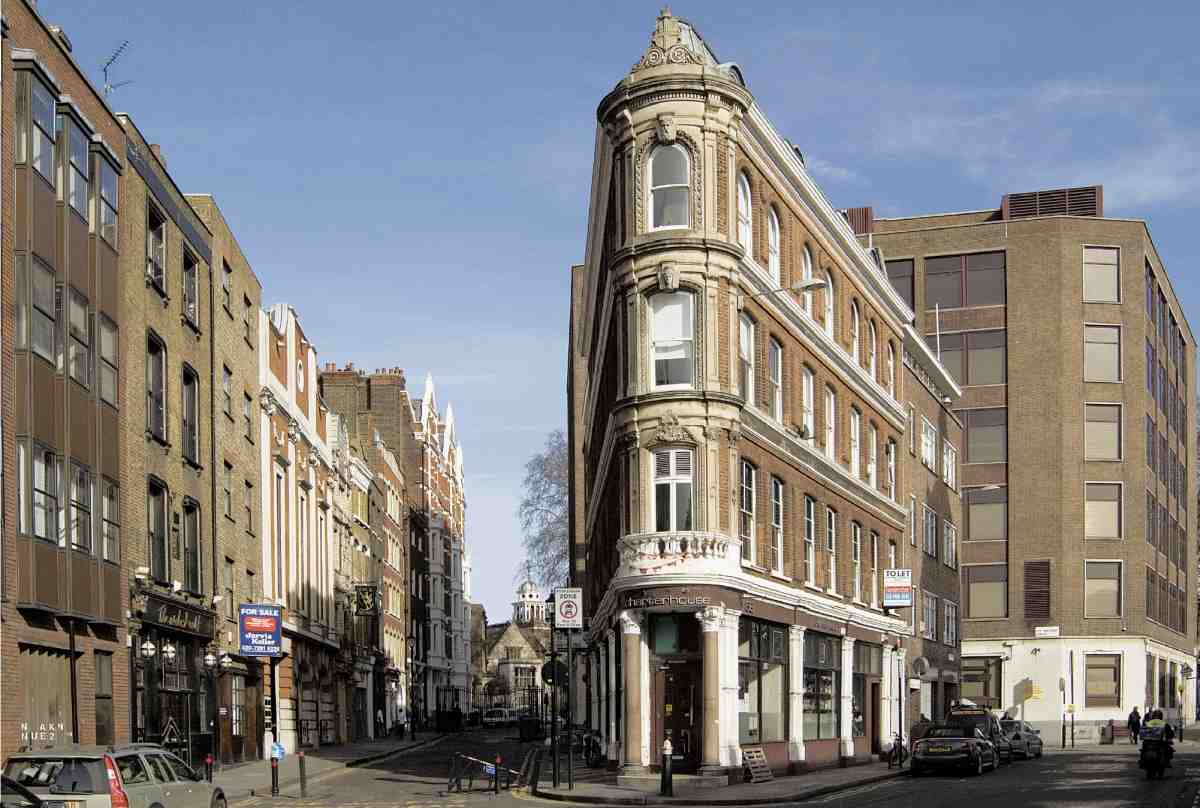Charterhouse Street starts at Holborn Circus. The first ‘No. 1’ building you see turns out to be No. 1 Ely Place, and the building below is in fact No. 1 Charterhouse Street.

17 Charterhouse Street is a large modern block next to Saffron Hill.

On the other side of Farringdon Road, Smithfield Market takes up all the sough side of the street. A new building being constructed on the north side is No. 33 Charterhouse Street which will provide 200,000 sq. ft. of new office space.

The first historic building is the former Port of London Authority building, built in 1914.

This in another one.

No. 55 Charterhouse Street

Nod. 57 – 61 Charterhouse Street with Comptoir Gascon linked to Club Gascon in West Smithfield.

No. 63 Charterhouse Street

Smiths of Smithfield, Nos. 67-77 Charterhouse Street

Fabric the club at No. 77A Clerkenwell Road

Nos. 79-83 Charterhouse Street

No. 85 Charterhouse Street

No. 87 Charterhouse Street with Paul’s sandwich shop, on the corner with Cowcross and St John Streets.

Formerly Barclays Bank, on the corner of Charterhouse Street and St John Street

No. 91 Charterhouse Street

No. 99 Charterhouse Street

The rest of this post is about a triangle of land near Charterhouse Square. This is the area of the ancient street called Charterhouse Lane. In the 15th century and before, Charterhouse Lane ran from the bottom of St John Street (opposite Smithfield) diagonally north to Charterhouse.
Modern Charterhouse Street is a long straight road, created in 1869, which runs from Holborn Circus to Charterhouse Square. But just before the square, there is a fork off the road into a cul-de-sac. This bit – the ancient Charterhouse Lane – was renamed Charterhouse Street. The Victorians’ long straight road carried on however, all the way to the junction at Aldersgate Street, but its name in this stretch was Charterhouse Square and then Carthusian Street.

This fork in the road system created a triangular island of land, with Charterhouse Street and Charterhouse Square making two long sides and a new lane called Fox and Knot Street near Charterhouse Square completing the triangle. In 1881 the street numbers of the former Charterhouse Close were dropped and the properties were all renumbered as Nos. 89 – 123 (odd) Charterhouse Street.
Nos. 38 – 42 (even) Charterhouse Street were built on the triangle of land. No. 38 Charterhouse Street was built as a warehouse for storing ostrich feathers! A whole warehouse for ostrich feathers! Admittedly one which ended at a point, so not the largest – but still, how many ostrich feathers can a nation need?

Nos. 40-42 Charterhouse Street was built to house a mission school, but it was rebuilt in 1956 to create Lindsey House which now contains a bar and offices.
On the north side, the first building in the cul-de-sac is Boundary House, Nos. 91–93 Charterhouse Street. This was built in the 1930s and given a neo-Georgian look, although in fact it is a steel-framed building with brick cladding. No. 99 Charterhouse Street is an office block built in 1983, with bronze panels.
No. 105 Charterhouse Street was once the Red Cow public house. Although the name has been changed several times, the memory of the Red Cow – its history went as far back as 1750 – is preserved in the two golden cow’s heads which are still on the front today.

Nos. 109 – 113 Charterhouse Street was built as a cold storage warehouse in 1900, and it was designed by a well-known architect, AH Mackmurdo. He gave it a frontage which is in the style known as ‘Wrenaissance’ – an unconventional mix of architectural features, all bundled together. In 1989, the building was demolished and rebuilt as an office development (now No. 111 Charterhouse Street) but the Mackmurdo façade was largely preserved.

No. 115 Charterhouse Street is the Fox & Anchor pub. The current version of this public house was built in 1898, although there had been earlier pubs of the same name on the site. Important features include its multicoloured ceramic façade which has created by WJ Neatby. He designed the interior of the Harrods Food Hall in 1902, which also makes extensive use of coloured ceramic tiles. In the 1990s, the Fox & Anchor was lovingly renovated by its new owners who were also involved with the Malmaison Hotel.


No. 117 Charterhouse Street was built as a vestry or parish office for the local parish of St Sepulchre in 1874. No. 119 Charterhouse Street is one of the smattering of Georgian houses in the area and dates from the early 1780s.

Nos. 121 – 123, built in red brick and stone, was originally a warehouse built in 1907 as a storage facility for the guests at the nearby Charterhouse Hotel. It was later used as rooms for the hotel staff. When the hotel went out of business in the 1920s, it was taken over by trades for cold storage and other uses.
Over the years, the meat trade gradually took over most of the available space in this part of Charterhouse Street, whether for cold stores, warehouses, factories or shops. Since the 1980s they have all left; and offices and the hospitality trade have replaced them.
